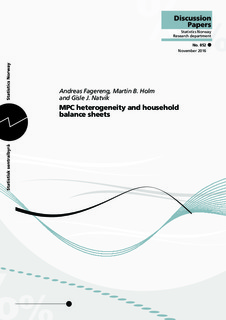| dc.contributor.author | Fagereng, Andreas | |
| dc.contributor.author | Holm, Martin B. | |
| dc.contributor.author | Natvik, Gisle J. | |
| dc.date.accessioned | 2018-01-30T12:17:31Z | |
| dc.date.available | 2018-01-30T12:17:31Z | |
| dc.date.issued | 2016-11-16 | |
| dc.identifier.issn | 1892-753X | |
| dc.identifier.uri | http://hdl.handle.net/11250/2480649 | |
| dc.description.abstract | Using Norwegian administrative data, we study how sizable lottery prizes affect household expenditure and savings.
Expenditure responses (MPCs) spike in the year of winning, with a mean estimate of 0.35, and thereafter fall markedly. Controlling for all items on the household balance sheet and characteristics such as education and age, MPCs vary with the amount won and liquid assets only. Shock size matters: The MPC among the 25 percent winning least is twice as high as among the 25 percent winning most. Many households are wealthy, illiquid and have high MPCs, consistent with 2-asset models of consumer choice. | nb_NO |
| dc.language.iso | eng | nb_NO |
| dc.publisher | Statistics Norway, Research department | nb_NO |
| dc.relation.ispartofseries | Discussion Papers;No. 852 | |
| dc.subject | Husholdninger | nb_NO |
| dc.subject | Forbrukerforskning | nb_NO |
| dc.title | MPC heterogeneity and household balance sheets | nb_NO |
| dc.type | Working paper | nb_NO |
| dc.subject.nsi | VDP::Samfunnsvitenskap: 200::Økonomi: 210::Økonometri: 214 | nb_NO |
| dc.source.pagenumber | 43 s. | nb_NO |
